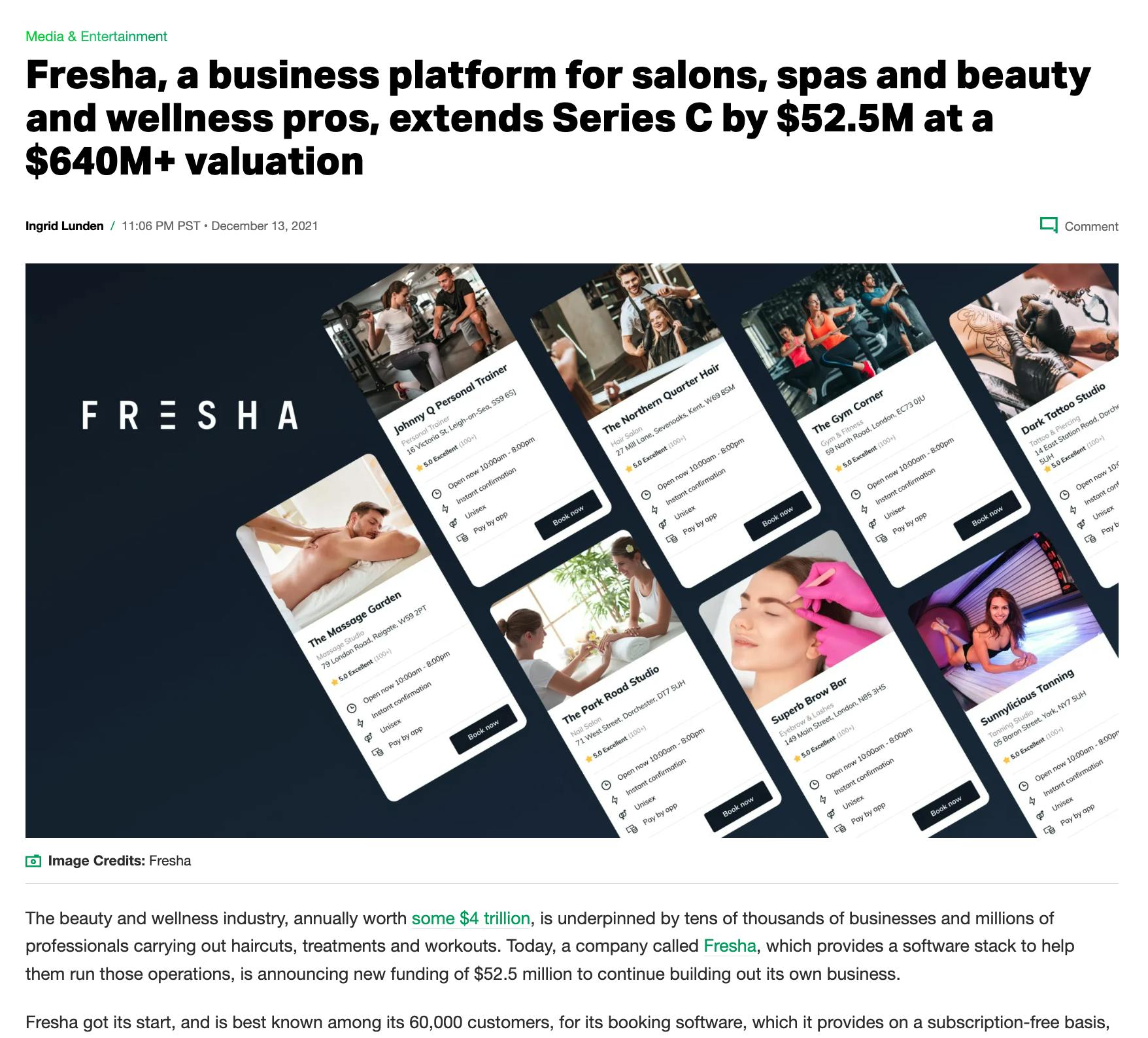How to build a website like Fresha
Fresha is a successful global marketplace for booking salon appointments. The technology to build a similar platform is available to everyone. Here's how you build a website—and a business—like Fresha.
Fresha, formerly known as Shedul.com, began as a tool for managing salon appointments. It later transformed into a leading appointment booking marketplace for salons, barbershops, and spas.
Today, Fresha is used by over 450,000 experts in 120+ countries. In 2023, Fresha generated $22.3M in revenue and experienced a 20.2% year-on-year growth, supported by $317.5M in funding.
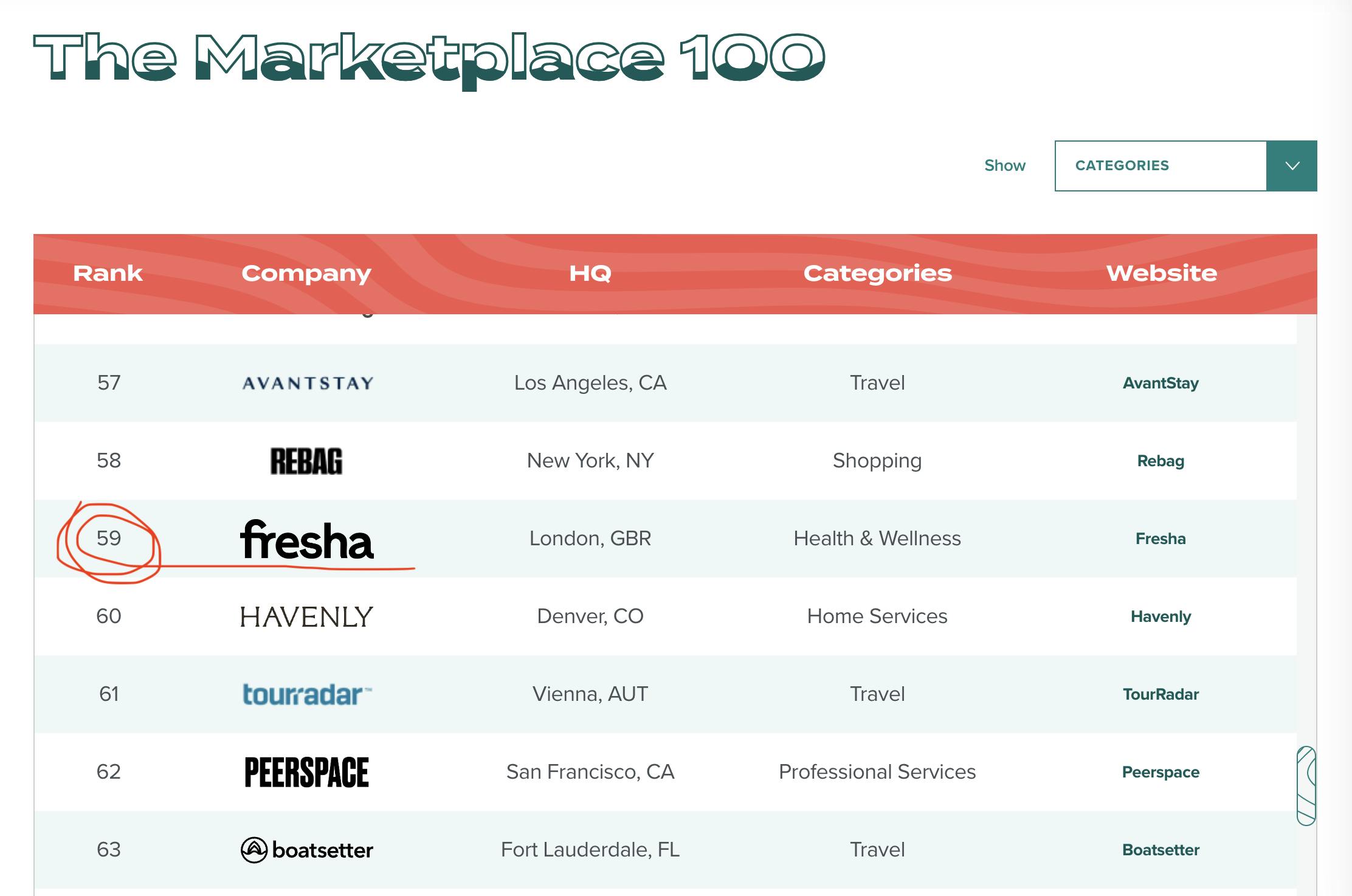
The beauty and wellness industry is continuously expanding, and there’s room for new players. If you're considering building a platform that works like Fresha, this guide is for you.
In case you're still not sure if you should pursue your idea, here are four reasons why it's a great idea to start a marketplace like Fresha
The first reason is the opportunity of the marketplace model in general. It’s amazing to see how online marketplaces are becoming a bigger part of eCommerce every year. By 2024, the top 100 marketplaces alone are expected to generate $3.832 trillion in total Gross Merchandise Value (GMV). This means that marketplaces have doubled in market size within just six years.
By 2027, third-party sales through online marketplaces are expected to be the biggest and fastest-growing retail channel worldwide.
The marketplace model is so successful because it makes buying and selling extremely efficient. Take a salon marketplace like Fresha. For customers, it's easy and convenient to browse through salon services, check real-time availability, and book appointments 24/7. For the salons, Fresha streamlines the booking process and makes it easier to schedule appointments and reduce the chances of overbooking or double-booking.
Plus, the data generated by online marketplaces is a goldmine. Salons can gain valuable insights into customer preferences and trends to tailor their services and marketing efforts more effectively. This data-driven approach helps them increase customer retention and loyalty.
Fresha is part of the $164 billion global spa and beauty salon market that is projected to reach $226 billion by 2030, thanks to a steady growth rate of 4.6%.
This impressive growth is fueled by the increasing number of people investing in personal grooming services—and the increasing use of online appointment booking platforms.
Fresha doesn’t own any spas or salons or sell beauty products. Instead, it connects consumers with nearby salons through its platform. Hence, as the spa and salon market expands, the demand for online beauty marketplaces like Fresha is likely to increase.
In fact, a market report by Mordor Intelligence predicts the salon & spa software market will grow by 10.9% till 2029, from the current $0.91 billion to $1.52 billion.
Big horizontal marketplace players are seeing increasing competition from smaller, more specialized businesses. These smaller, vertical players have the advantage of focusing on a small niche and serving it extremely well—much better than more generic established platforms.
This is a tremendous opportunity for early-stage founders. To thrive in the same niche as Fresha and it's large-scale competitors, you don't have to go against the giants. Instead, identify a smaller audience that isn't getting all its specialized needs met on these platforms.
A strong local focus is a great way to niche down. Another option is to specialize in just one of the categories Fresha offers. This can help you stand out and offer a better experience to your customers.
Take Queer Healers, for example. They’re a Sharetribe customer that focuses solely on LGBTQIA+ healing and wellness practitioners. By focusing on this niche, they are providing a more personalized and inclusive experience.

In the past, building a two-sided booking platform like Fresha required significant technological expertise and a dedicated development team.
Today, marketplace SaaS solutions like Sharetribe make the technology available to everyone.
Sharetribe lets you launch a marketplace with essential two-sided booking, payment, and management tools without any coding knowledge. As your needs grow, you can then customize and adjust with code to create a unique offering suited to your niche.
So, the major trends are in your favor if you’re building a marketplace like Fresha. If you're ready to give your idea a go, you can create your marketplace in just a few steps here.
Fresha and its competitors are often referred to both as “booking platforms” and as “salon management software.”
This is because Fresha’s platform serves two sides: the customers and the salon owners. If you're building a marketplace like Fresha, you'll need a compelling value proposition for both these user groups.
Fresha didn’t start as a two-sided marketplace. It started as Shedul.com, offering software specifically designed for managing salon appointments: appointment scheduling, client management, point-of-sale sales management, and so on.
This made it very easy for Fresha to build its supply of spas and salons before there was any demand or marketplace functionality in place. Because of the high quality of their salon software, salons got more than enough value by using Fresha (or at that point, Shedul.com) even if it didn't help them get more customers.
Top-rated salon booking management software continues to be Fresha's key value proposition to salon owners and professionals.
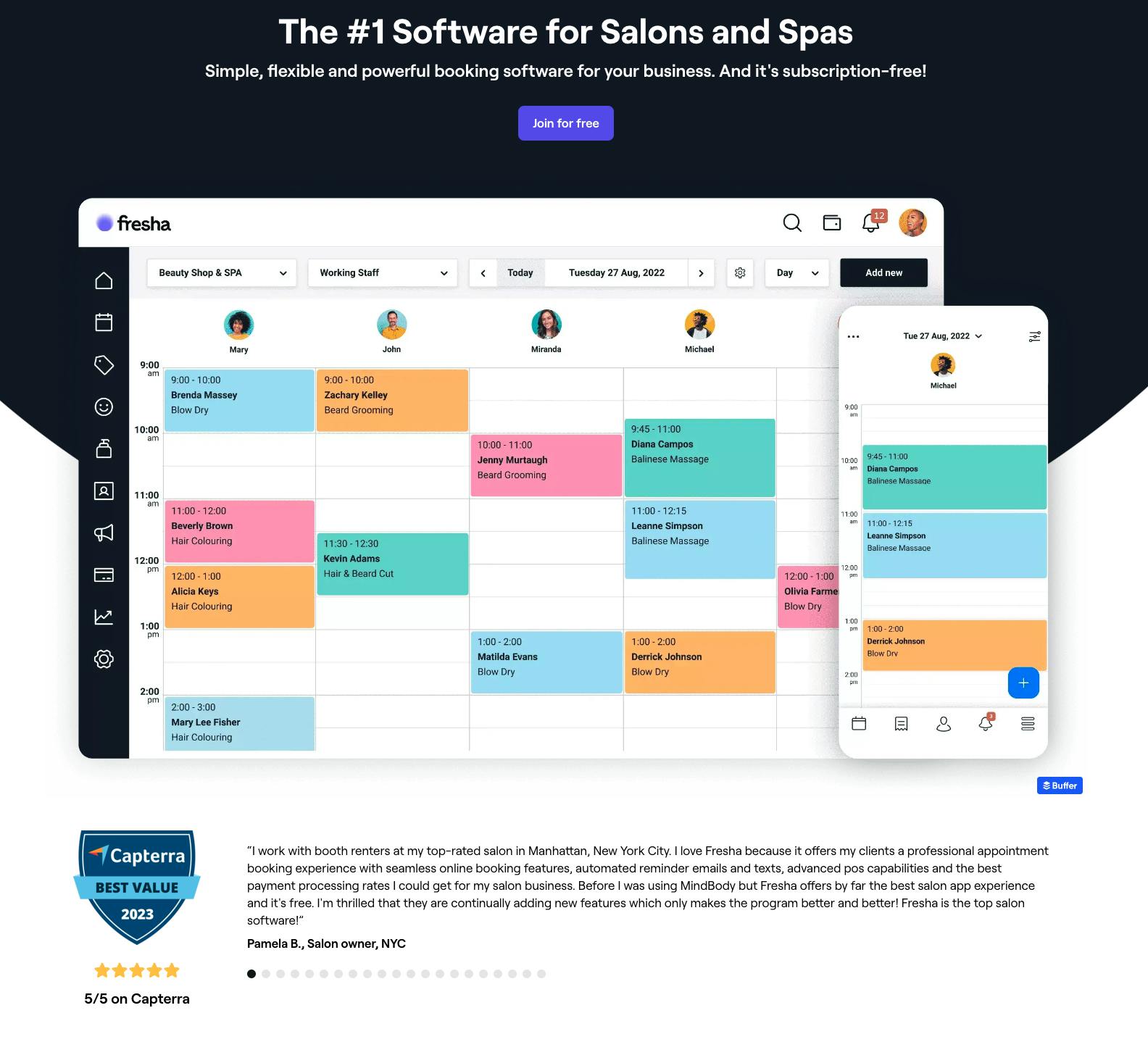
Creating a "single-player mode" is not an uncommon tactic to solve the marketplace chicken and egg problem. Many successful marketplaces across niches have used a compelling SaaS offering to give their supply side a good reason to be on the platform before there's any promise of buyers.
The great advantage of this strategy is that Fresha could launch it's demand-side functionality with a high-quality supply of dedicated salons and spas on its offering.
Along with its two-sided marketplace, Fresha's features and value proposition to salon owners has expanded. Salons create their storefronts on Fresha for customers to browse, and in addition to booking managment, Fresha now offers payment processing, attracting new clients, and managing marketing campaigns and messages.
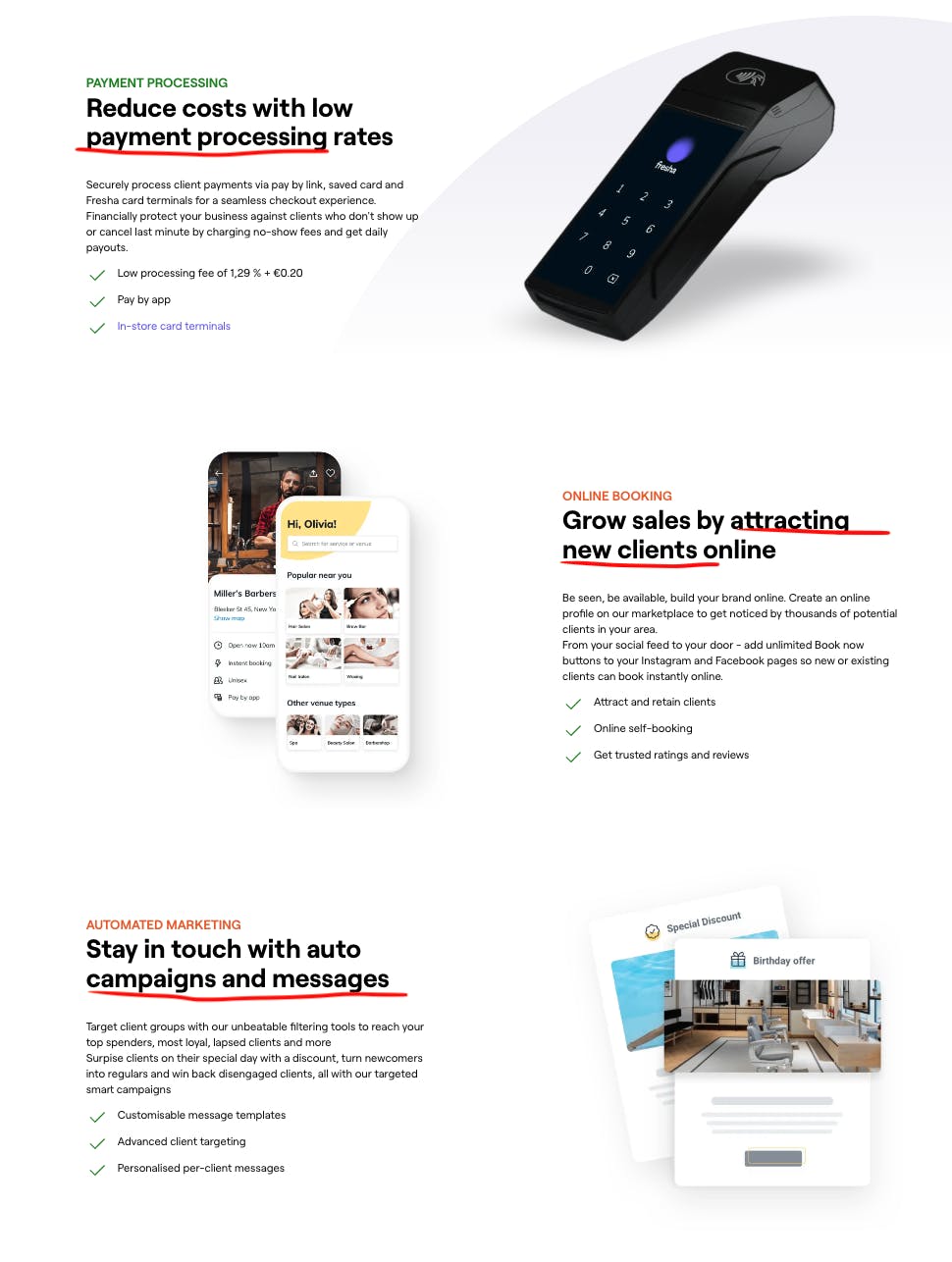
These features are possible because Fresha also has the customer side using the platform to find, book, and pay for appointments.
Over time, Shedul.com evolved into Fresha and became a two-sided marketplace. In addition to the appointment management interface, Fresha now provides an interface to book appointments for consumers. The customer side of the experience is now the primary value proposition when a new user visits the Fresha.com homepage.
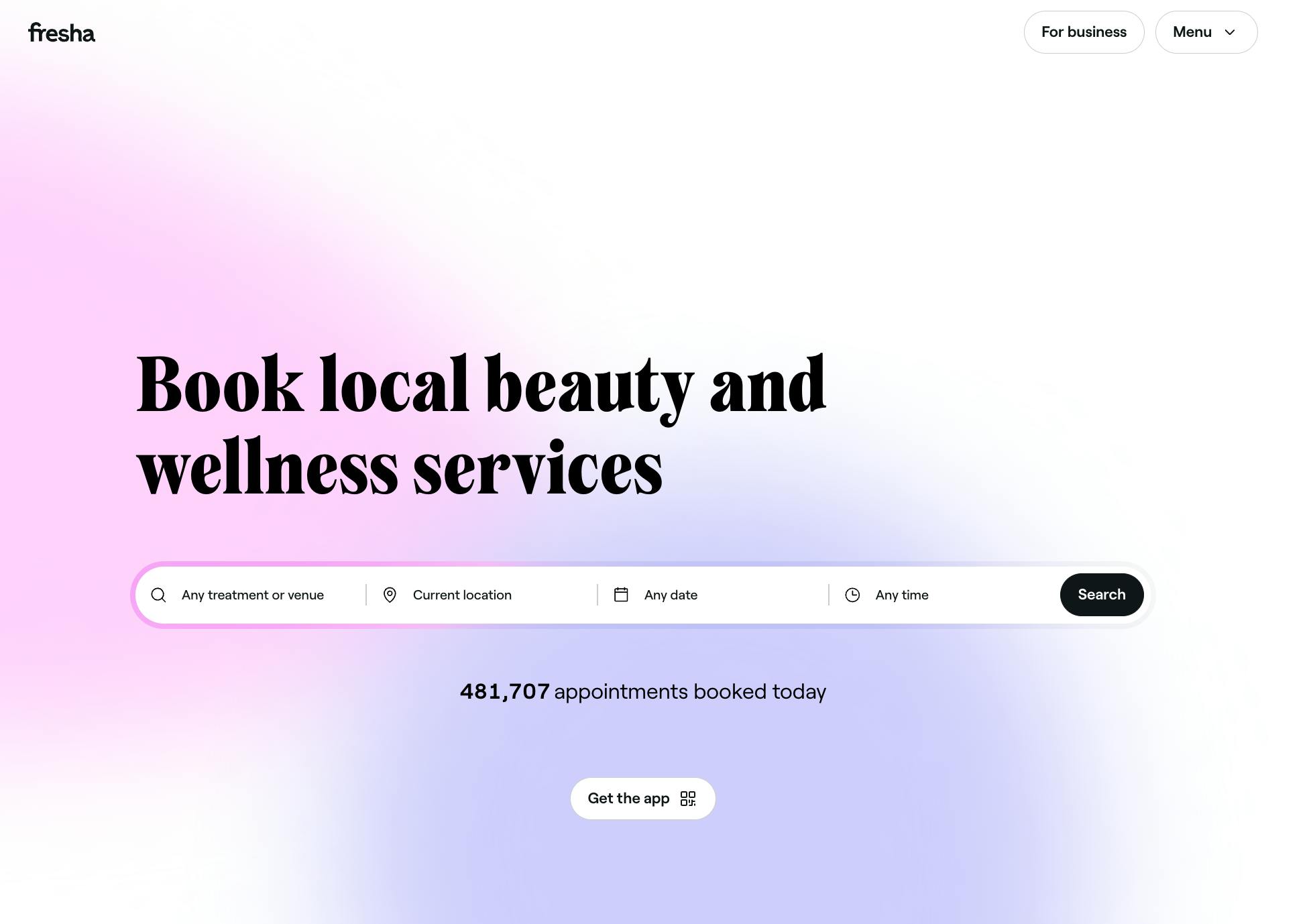
Users can search for service providers on Fresha by treatment, venue, location, date, or time. Results are shown on a map. Here, for example, are the eyebrow and lash appointments available in Indianapolis tomorrow.
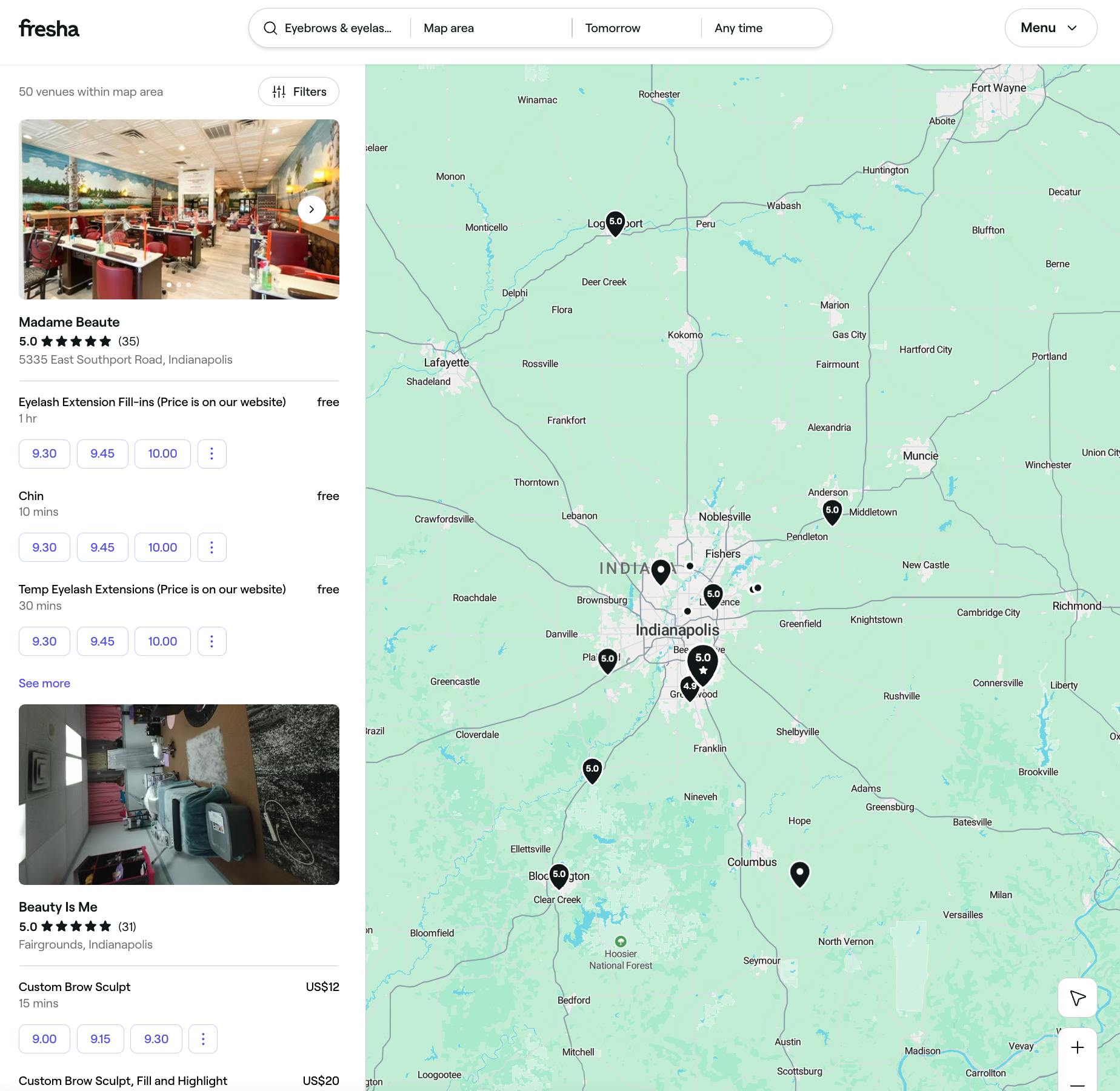
As you can see from the homepage, Fresha's value for the customer side isn't in the platform technology. It's in the selection. Fresha showcases this by displaying the massive number of appointments booked today. They also have a section directly below the header that showcases recommended, new, and trending listings on the website.
At the same time, Fresha's customer-side UX is very robust, technologically speaking. It includes a powerful listing search based on different search criteria, a visual representation of appointment slots that can be booked, user signup, and a lot more.
A website like Fresha is a prime example of how building a marketplace is actually like building two individual businesses: one for the sellers, one for the buyers.
This explains why marketplaces are such complex (not to mention expensive) websites to build. Fresha today employs over 100 developers. Our mission at Sharetribe is to make it possible even for non-technical founders to launch a similar website at a fraction of the time and cost. This gives founders more time to focus on building the business side of things—which we'll discuss next.
Online marketplaces like Fresha usually follow one or a combination of these six marketplace business models:
- Commission
- Membership/subscription fee
- Listing fee
- Lead fee
- Freemium
- Featured listings and ads
By far the most marketplaces use commission (including nearly all of Fresha's competitors): they take a cut out of every transaction that happens through the marketplace.
Fresha, however, stands out by offering its core salon management software for free and not charging anything for bookings made on Fresha by existing customers. Instead, Fresha offers optional paid fears, including:
- Payment processing. Fresha offers a solution for processing payments online and in the salon, for which a commission fee for each transaction applies.
- New client fee. Fresh charges a one-time fee for every new customer a salon acquires viea the Fresha marketplace. After the first transaction, there are no further fees on that customer.
- Blast campaigns. Businesses can send promotional texts and emails to their customer base for a fee per message. All the technology is available inside the Fresha app, making it easy to use.
- Insights. Salons can analyze their customers' data to derive valuable insights into booking items, cancellations, peak hours, etc. This feature is an add-on service that costs a fee per team member and can be canceled at any time.
- Team pay. Fresha offers built-in payroll software to simplify payments to employees and contractors. This feature comes with a monthly subscription fee, making payroll management easier for salons.
- Google rating boost. This feature helps salons get more ratings and reviews on their Google business profile. Salons can send review requests to their customers through the app for a monthly fee.
This fee structure has helped Fresha build a loyal user base and differentiate itself from competitors.
When Fresha first launched in 2015 (as Shedul.com), there were big established players in the salon booking software space to compete against. Yet it stands out and is currently the #1 booking and appointment management platform for salons and spas and entered the Top 100 Global Marketplaces ranking by Andreessen Horowitz.
So, if you're building a marketplace in the same niche, it's worth trying to understand the factors behind Fresha's success.
Fresha's salon management tools have a very strong product-market fit.
The founders spotted a problem to be solved among beauty professionals and have been empathetic to their users' specific needs. Managing availability, bookings, cancellations, and payments for several service providers is very complex. A technological solution can help, but it needs to be very simple to learn and use because salon owners aren't technology professionals. At the same time, committing to a high monthly cost of existing salon software solutions was a dealbreaker for many independent small business owners.
Speaking on the 52.5M Series C funding round in 2021, co-founder and CEO William Zeqiri was quoted saying, “Stylists [and other beauty and wellness professionals] are not really trained in business management, our goal is to free that up and automate all aspects of their business.”
This dedication shows today in consistently praising reviews and being ranked as the best salon booking and management software on sites like Capterra.
Most marketplaces face the chicken-and-egg problem in their early days: how to build supply without demand and demand without supply.
Fresha's solution was to focus on building supply. The founders built a great SaaS offering to attract a large number of spas and salons to the platform. Free software to solve crucial pain points for salon owners was a solid reason to join the platform, even if it didn't help salons find more customers at first.
When Shedul.com transitioned into the two-sided marketplace Fresha, it could launch to the demand side with a highly competitive offering.
A third factor to highlight is the founders' readiness to iterate and adapt their offerings.
William Zeqiri said in an interview, “Since day one, we have focused on solving major challenges to make our customers happy. We spend much time talking to our customers and acting on their feedback, enhancing our platform to suit their needs. That’s how we’ve built an award-winning product that can sell itself.”
For example, the Covid-19 pandemic represented an obvious challenge for salons and spas—and businesses like Fresha whose success is dependent on them. But the founders were able to identify an opportunity within that challenge and added a new branch to their site just for beauty and wellness stores. This gave businesses a way to sell their products and services online and even design their own sites on the Fresha platform. It was a smart move that helped everyone get through difficult times together.
Just because Fresha has found success in the appointment booking industry doesn’t mean the market is closed off. Next, let’s look at how some Fresha competitors differentiate themselves—and how you can build a successful alternative to Fresha.
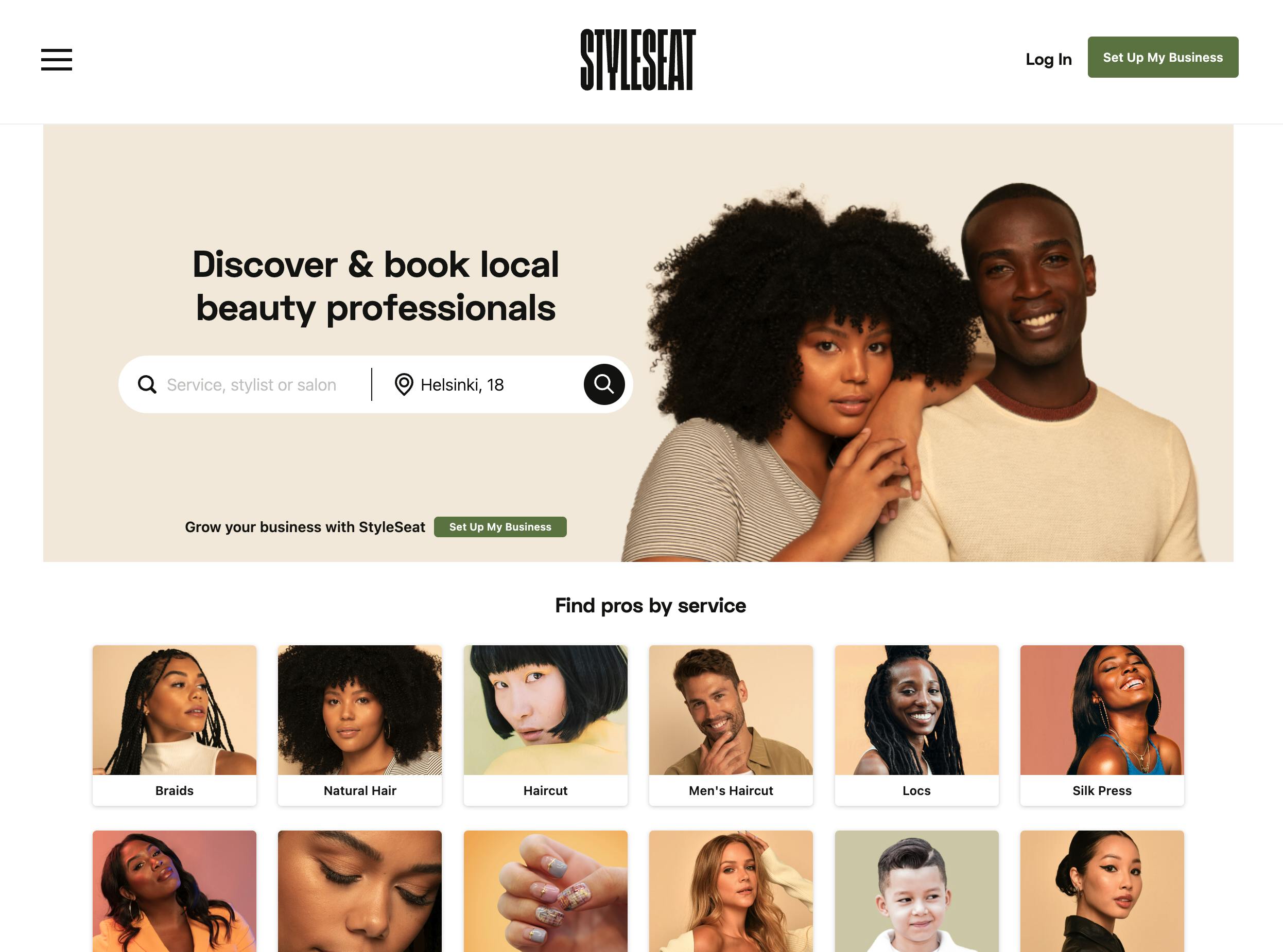
Styleseat is a strong competitor of Fresha in the salon appointment booking space. Both platforms offer similar features and target the same audience.
Founded in 2004 by Katie Rae and Rebecca Minkoff, Styleseat started as a platform for stylists to manage appointments online. Over time, it evolved into a comprehensive business management tool for the beauty and wellness industry. Styleseat allows consumers to find hairstylists and barbers in their area and book appointments through the app.
If you’re building a website like Fresha, it’s worth going through Styleseat’s interface too to gain additional insights.
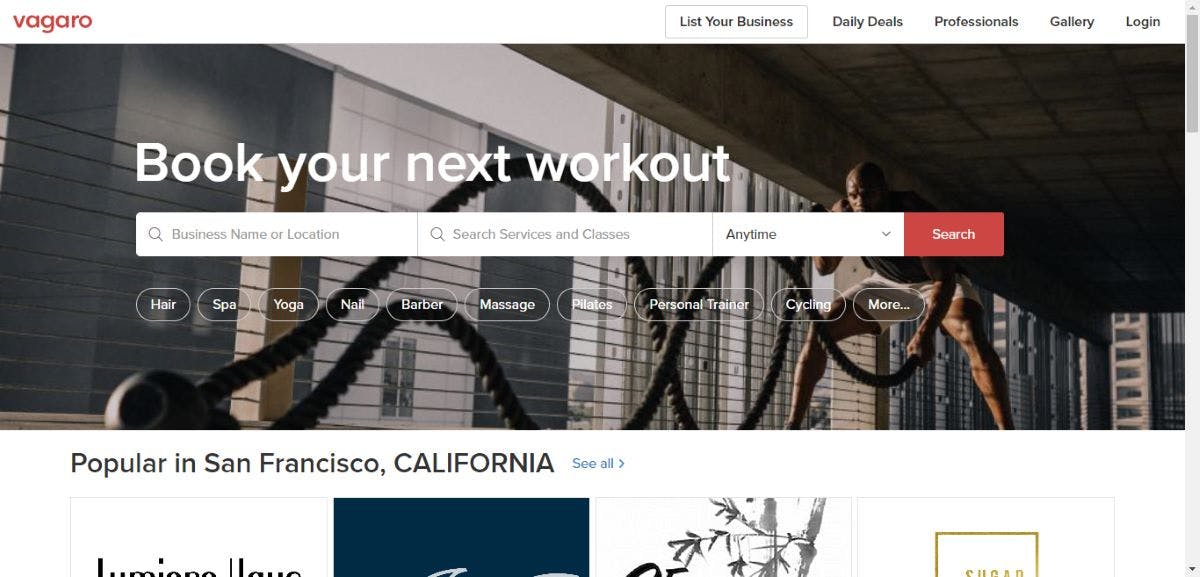
Another business similar to Fresha is Vagaro. With its $1B valuation, the unicorn is the incumbent and the largest Fresha competitor.
Founded in 2009, Vagaro established itself as a popular platform for appointment scheduling and management in the wellness industry. Compared to Fresha, Vagaro has a broader reach. Besides salons and spas, consumers can book nutritionists, cyclists, mental health workers, and even pet workers. At the time of writing, the website has processed over 136 million bookings.
The company also offers more robust features like Pay Later, inventory management, and white labeling. Thus, it goes beyond the traditional salons and spa management software.
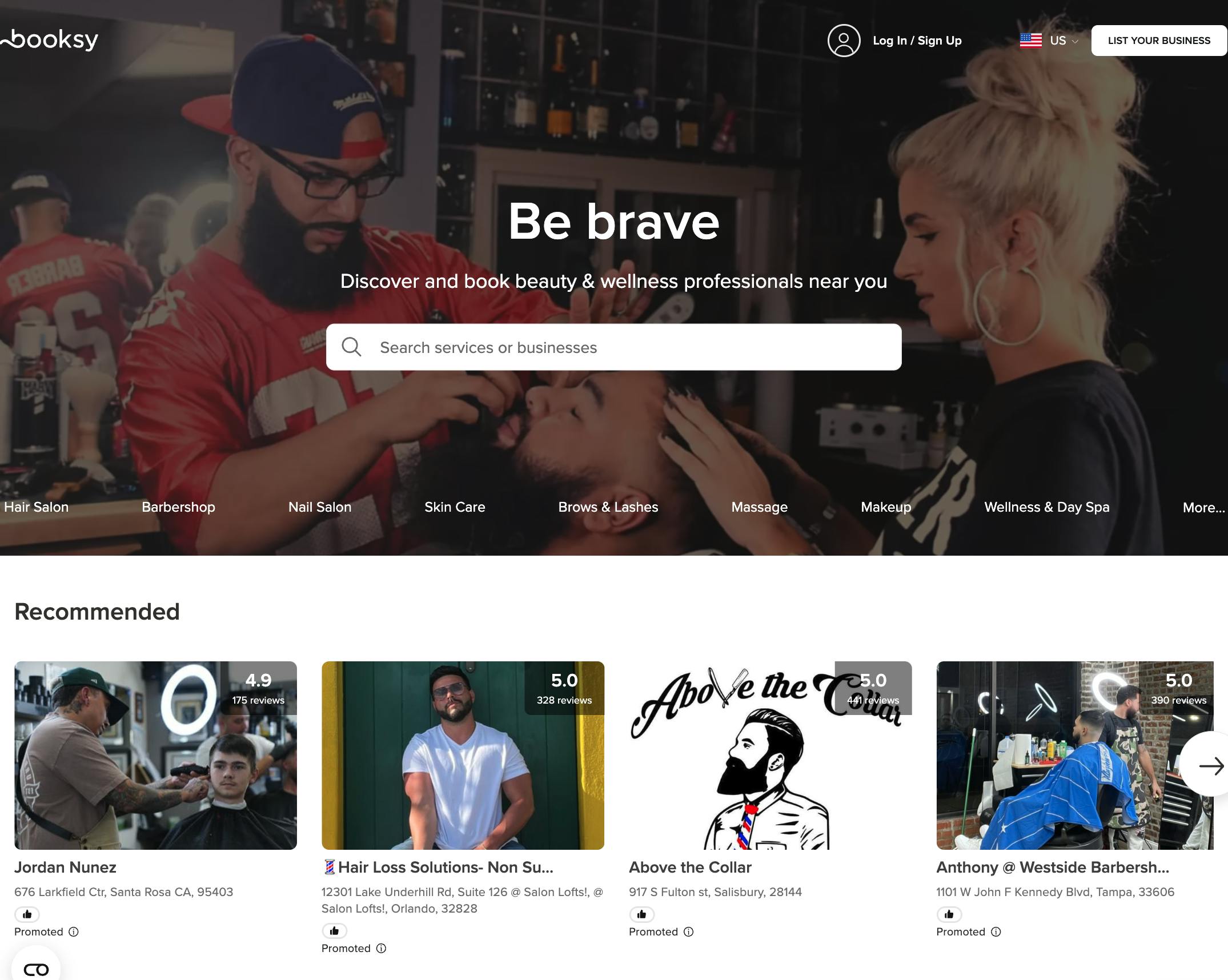
Booksy is very similar to Fresha in its offerings. The website connects beauty and wellness professionals with customers, and for businesses, it has a complete management suite. The platform acquired Genbook in 2021 and has since offered all of Genbook’s most loved features.
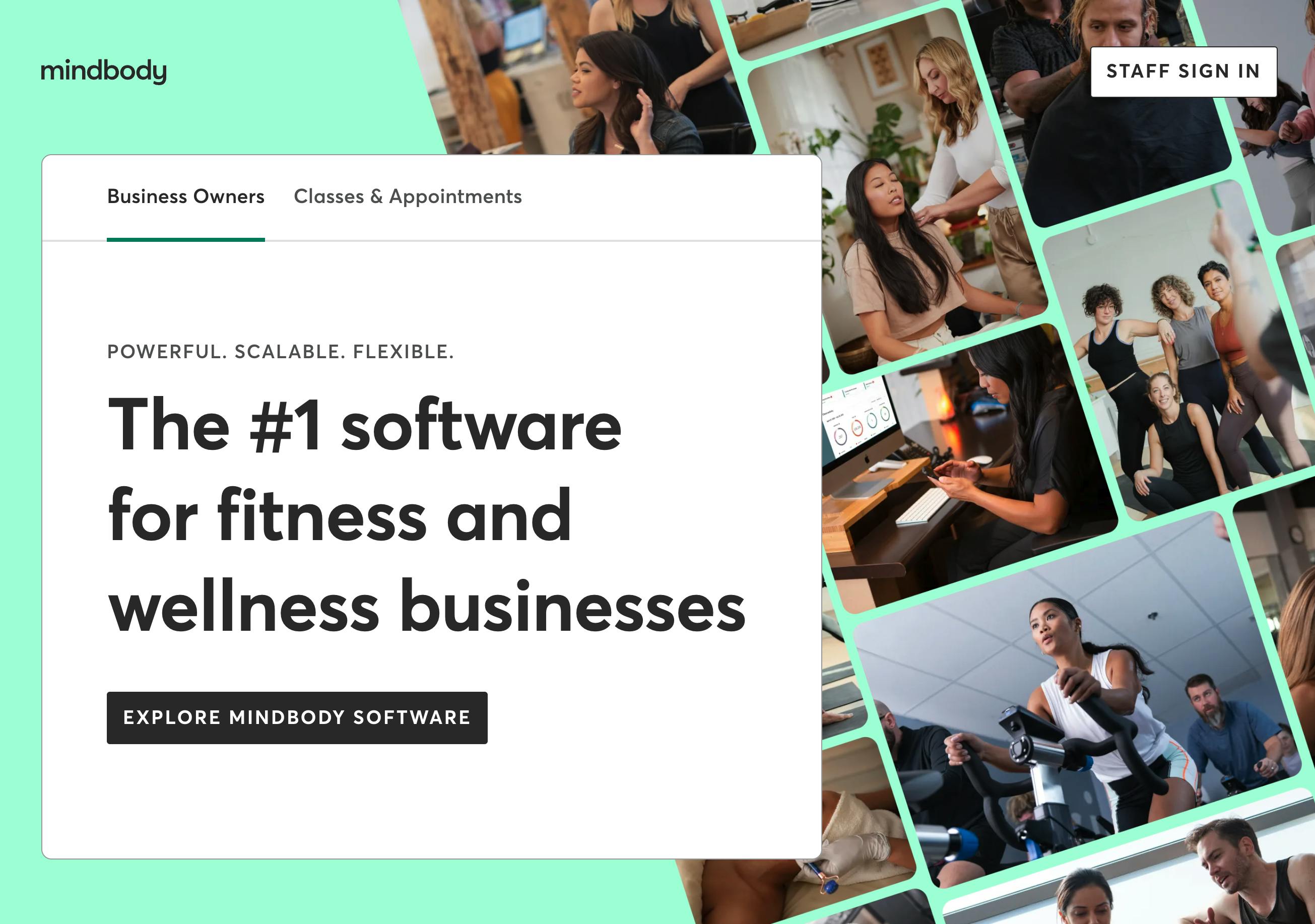
MindBody isn’t a direct competitor to Fresha in the same way as platforms like Styleseat. It focuses on the entire fitness and wellness industry, encompassing businesses like yoga studios, pilates studios, gyms, massage therapists, and even some salons.
Founded in 2000, Mindbody is one of the oldest websites in the space. Business owners can find everything from appointment booking to PoS systems. As a marketplace, it connects consumers with wellness and fitness providers.
Building a marketplace is hard. Even if you use a marketplace SaaS tool like Sharetribe to power your platform. Getting the two-sided dynamics running can take much longer that starting a more traditional business.
At the same time, seeing a two-sided marketplace come to life is incredibly rewarding.
At Sharetribe, we've worked with marketplace founders for over a decade. Based on this experience, we've identified a ten-step process with practical steps that take you from idea onwards, all the way to scaling your business into new markets.
The ten steps are:
- Identify a strong marketplace idea.
- Choose the right marketplace business model.
- Start with a focused scope.
- Pre-validate your marketplace idea.
- Build a marketplace platform, starting with an MVP (Minimum Viable Platform).
- Onboard your first sellers.
- Launch your marketplace.
- Reach problem-solution fit.
- Reach product-market fit.
- Scale into new markets.
I'll introduce each of these steps in brief below. For the full story, head to the complete guide to creating a marketplace.
Your marketplace should center around a strong idea. Based on our experience, a great marketplace idea hinges on four key factors:
- It addresses a genuine problem for both buyers and sellers.
- It targets a market large enough to meet your business goals.
- The market is fragmented, with many suppliers and customers.
- There’s potential for frequent usage, encouraging repeat transactions.
At Sharetribe, we’ve observed that successful founders often discover their ideas in three main ways:
- They identify a problem they personally experience.
- They notice underused assets, inefficient buying processes, or fragmented markets.
- They find a niche market that existing platforms don’t serve well.
If you're building an alternative to Fresha, you could have a look at forums and communities where salon owners discuss and see if you can identify common painpoints or unment needs. For example, there are many subreddits like this one and this one where salon owners discuss their needs and their experience on Fresha and Fresha competitors.

Choosing the right marketplace business model is a critical decision for your business. As you learned, Fresha uses the freemium model and charges sellers for additional services.
When we studied how the best marketplaces monetize, we found that most marketplaces monetize through commissions. For service marketplaces (such as platforms like Fresha), subscription fees are also common.
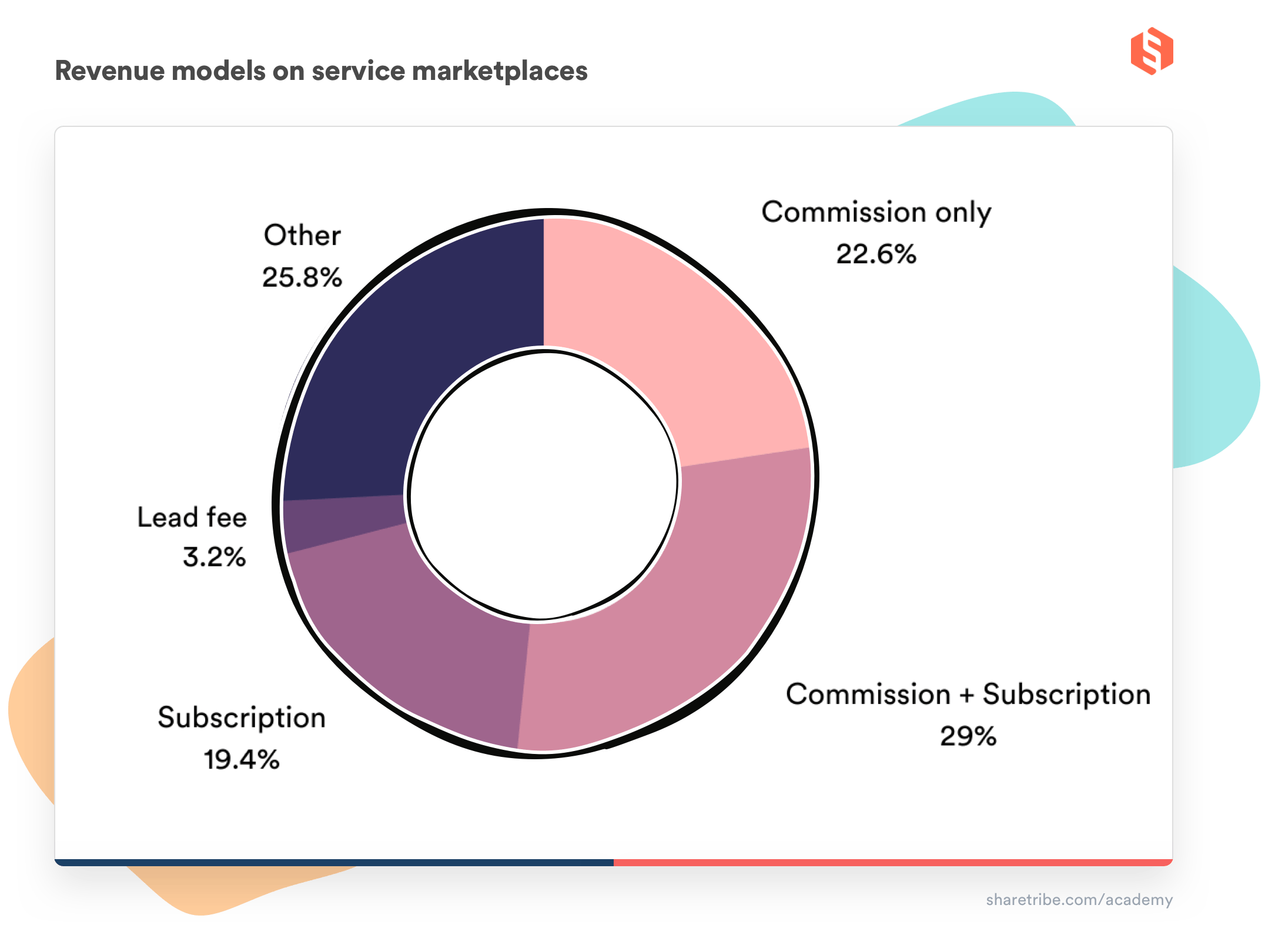
Commission is a great way to monetize, particularly in the early stages. The fees are tied to the value that the marketplace offers: users aren't required to pay anything up front, but if they transact, the marketplace collects its fee.
Commission is often the quickest business model to get off the ground, and also tends to scale really well.
Marketplaces are famously scalable. But even some of today's biggest, most successful marketplaces started with a small niche and expanded iteratively.
Fresha is a great example of how a marketplace business is actually two businesses on one platform. Both the sellers and the customers need a good reason to be there. This dynamic is much easier to establish with a small group of users.
Furthermore, a focused scope can help you compete against big players. That's how Fresha has been able to carve out space from big, established players like Vagaro. You, in turn, can compete against Fresha by niching down even further. Start by building a solution dedicated to your location, or take an example from Sharetribe customer Queer Healers and identify an audience group that's not served well on generic platforms.
An analysis of 110+ failed startups by CB Insights claims that 35% of startups failed because there was no market need. Pre-validating your idea helps you avoid this mistake.
Pre-validation can be as simple as talking to your target audience in person and online in a structured way. List the assumptions behind your idea and then ask open-ended questions to understand if your assumptions are correct. Here's an article on pre-validating your marketplace idea with practical examples.
If the feedback shows that some of your assumptions were wrong, don’t worry. Just adjust your approach and validate again. This iterative process helps you refine your idea and make sure it truly meets the needs of your audience.
After you have initial validation for your idea, you can start building the platform. Start with an MVP: Minimum Viable Product.
Your MVP is the minimum number of features and functionalities needed to solve the core problem for your service providers and customers better than any existing solution.
For a salon booking marketplace like Fresha, this likely means online bookings for customers and booking management for spas and salons. For example, here's what Shedul.com looked like when it first launched in 2015.
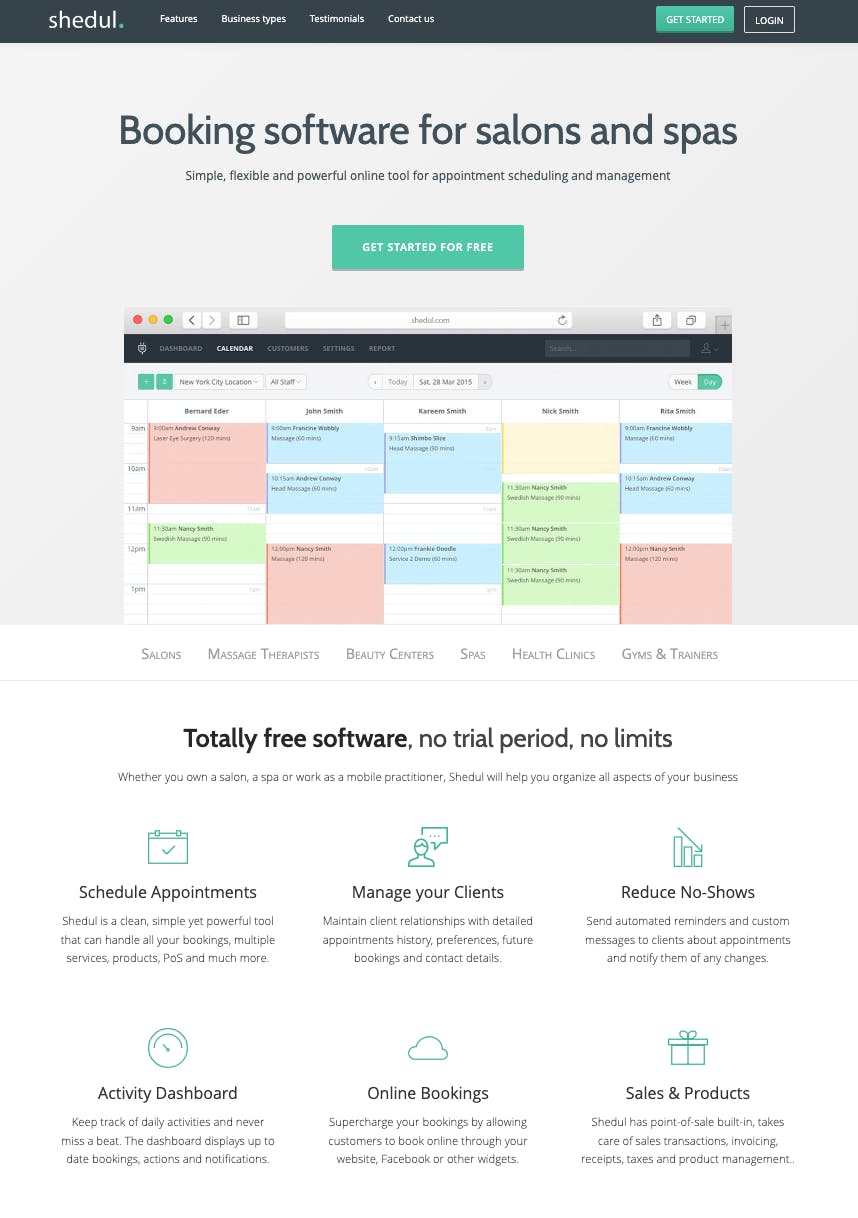
Sharetribe’s no-code marketplace builder is a great candidate for your MVP if you're building platform like Fresha. It comes with the core features to offer a great experience for both sides of your audience:
- Storefronts and powerful availability management for salons.
- Smooth online booking and payments for the customers.
- Two-sided reviews to build trust.
- Admin tools for the marketplace founder.
- And a lot more.
In addition, you can easily add custom-coded features on top of the no-code essentials. If you don't have a developer on your team, you can find one through Sharetribe's global network of vetted experts.
Next, you need to onboard one side of your marketplace. In most cases, it’s easier to onboard the sellers first.
As you know, Fresha first launched to businesses by offering a subscription-free management platform, called Shedul.com. This allowed Fresha to stock up enough sellers on its marketplace to entice the other side, the consumers.
In fact, William Zeqiri hypothesized that this is the only way to build a business in a crowded market.
To this day, Fresha’s appointment booking software and the great reviews it has gotten continue to be the key value proposition for the supply side.
Once you have the sellers, launch your marketplace to the customer side.
Your initial supply of salon and spa owners likely brought their existing customers to the platform. Now, you need to show them that your marketplace also helps them get new business.
From this point on, the key to your success is how well you can balance supply and demand. Your existing supply needs to feel like your marketplace is providing them added value. At the same time, you can't bring in more demand than your supply can serve.
So, don't launch to the entire world yet. Instead, find just enough new customers to serve your supply.
You've likely already gathered some initial interest during the pre-validation stage. Here are a few additional sources to consider:
- Online groups and communities. Join Facebook groups, subreddits, and other online forums where your target audience hangs out.
- Offline groups and communities. Visit local flea markets, gyms, daycare centers, and other community hubs where your potential customers gather.
- Paid search engine ads. Allocate a small budget to run ads on search engines
- Referrals. Marketplaces like Fresha are often great at generating word of mouth, which you can and should tap into.
When you have your initial user base established, you can start working towards problem-solution fit for your marketplace.
Reaching problem-solution fit validates that you have identified a genuine problem among users and built the right kind of solution for it. If you start scaling your marketplace before this validation, you risk making the potential issues in your product and business model more difficult to fix.
You'll know you have a good problem-solution fit if you see:
- Regular, recurring transactions
- A slow, gradual increase in transactions over time
- Transactions occurring with less and less direct intervention from you (if you've been manually facilitating them).
If you don't see signs of problem-solution fit, don't get discouraged. Contact your users and try to understand how you can tweak your approach.
“Fresha outpaces the competition by combining a superior product-market fit with outstanding execution capabilities.”
Product-market fit comes after reaching problem solution fit. It validates that you're targeting a big enough market with a product that satisfies that market. Signs of having found product-market fit are:
- High marketplace liquidity
- High repeat purchase rate
- High GMV retention
- Good unit economics (CLV > CAC)
Reaching product-market fit forms the foundation of scaling your business. Again, if you scale before reaching product-market fit, you risk amplifying unsolved problems.
Nowadays, reaching product-market fit is much more important for potential investors.
The above quote is from one of Fresha’s investors and General Partner at Partech, Phillippe Collombel, on the eve of Fresha's $100M funding round.
Fresha started with a seed funding of around $1 million in 2016. It raised another $20 million in Series B funding in 2019 before eventually raising $100 million and $52.5 million in Series C.
Your Fresha-MVP likely took you as far as Step 8, but when you're going after product-market fit, it's very likely you need to invest more into your marketplace platform. If your MVP is powered by Sharetribe, this is easy. You can easily expand on the now-code features by adding custom-developed features and functionalities.
The last step to building an online marketplace like Fresha is identifying other viable markets and expanding into them. Fresha has successfully expanded into over 120 countries.
There are three ways a marketplace can scale:
- By adding a new location.
- By adding a new category.
- By adding a new customer segment.
Having reached product-market fit, you now have a solid playbook to reach in your new markets or categories. Scale into one new market at a time, reach product-market there—and repeat in the next new market.
It's never been a better time to start a marketplace like Fresha.
The beauty and wellness industry is growing, and so are online marketplaces. Thanks to the emergence of no-code marketplace SaaS tools, it's also never been easier or more affordable to get started.
At the same time, building a marketplace is a challenge. A two-sided marketplace like Fresha is, in many ways, two different businesses: one for the salons and spas, and one for the customers. You need a strong value proposition for both sides of your audience to grow and succeed with your business.
The best way to succeed is to start small. Identify a location or a niche that Fresha isn't serving well. Focus your efforts there and create a Minimum Viable Product that serves the needs of your small audience better than any existing solution. With Sharetribe, you could launch such a website in just a matter of days.
Fresha succeeded because the founders were empathetic to their audience and iteratively developed a product to serve its needs. When you launch an MVP fast, the early feedback from your first users becomes your competitive advantage in the growing beauty and wellness market.
Best of luck with your marketplace!
Start your 14-day free trial
Create a marketplace today!
- Launch quickly, without coding
- Extend infinitely
- Scale to any size
No credit card required

